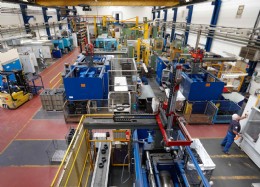Elastomer liner - the key to success for KSB

Figure 1. Section through a soft-seated centred ISORIA butterfly valve showing the three important sealing points.

The elastomer production line at La Roche-Chalais
Tight sealing at the flanged line connections is achieved by compressing the liner between the body and the pipe flanges. In the closed position, the disc seals the valve by pressing its edge into the liner. This compression uses the elasticity of the liner to avoid damage during the penetration of the disc. The penetrating disc also ensures that butterfly valves remain tight even if the differential pressure is relatively high.
While standards for metal materials prescribe the quality of the metal, its mechanical and chemical properties, as well as the surface quality, comparable standards for polymers do not exist. Elastomer is only given its properties in the course of the production process, with its quality being dependent on both the production process and vulcanisation. The properties required for liners of butterfly valves are many and include: elasticity, hardness and duration for tightness, good friction coefficient for opening and closing operations, chemical compatibility, and resistance to ageing in terms of temperatures chemicals. The composition, the mixing process and then the kneading are crucial for obtaining its final properties.
This applies in particular to the visco-elasticity of the elastomer, which is its capability to deform under load and revert to its original state after a given period of time. Tight shut-off is achieved through the contact between the edge of the metal disc and the liner. It must not decrease if the valve remains in the closed position for a prolonged period of time. The synthetic rubber must not show any signs of compression from the valve’s disc. Referred to as the compression set, this a property dependent on the material’s visco-elasticity. During valve opening and closing, the disc is in contact with the liner. This action must not cause wear to the liner and the friction between the two elements must not result in an increased actuating torque.
The right geometry of the contact areas of the elastomer and the metal as well as the tolerances which allow the elastomer to deform makes the design of the parts extremely complex. However, it is of crucial importance for the valve’s quality and service life. In the case of KSB’s butterfly valves, the shape of the liner is designed using CAD (finite element method). This ensures the exact determination of the contact between the disc and the liner in order to minimise the operating torque, thereby reducing the size of actuators and reducing energy consumption.
KSB has a policy of keeping elastomer its expertise within the Group because this ensures that it can influence the product’s quality and respond to customer needs.
KSB’s valve factory in La Roche-Chalais, France, manufactures 420,000 liners for 1,600 different products each year (Fig.2). This means that 200 to 220 tonnes of synthetic rubber are produced using about 40 basic formulas. This variety is necessary to cover a wide range of media such as fluids, gases, aggressive media or food as well as operating conditions with temperatures from - 20°C to + 200°C and pressures up to 25 bar. A further issue that has to be taken into account is the regulations and different technical codes.
The rubbers used by KSB are a mixture of 60% basic elastomers, approximately 30% carbon black used as reinforcing additive, 5 - 10% plasticisers and vulcanisation agents. Finding the right mixing ratio is a highly complex task which takes into account the subsequent production processes (injection or compression moulding), the volume and the shape of the parts to be manufactured. New rubber types are developed at the La Roche-Chalais factory, while the elastomers are subjected to permanent testing at KSB’s research centre in Gradignan.
KSB closely cooperates with partners such as the Research and Control Laboratories for Synthetic Rubber and Plastic (Laboratoires de Recherches et de Contrôle du Caoutchouc et des Plastiques - LRCCM) Cetim and Elastopôle. KSB believes that its programme of research and development enables it to continue providing longlasting liners for up to 30 years in accurately specified service conditions.
KSB
Tel: +44 1509 231872
www.ksb.com
Published: 28th June 2013
Rachel Wormald, Managing Director at YPS Valves Ltd and Elizabeth Waterman, ...
Are you looking for industry-leading, brand independent valve and actuator ...
As can be seen from the photograph, clearly the resident birds at Bartlett ...
Howco Group has unveiled its latest £1million investment, with the ...
In 2024, Allvalves is poised for an exciting year of growth and expansion, ...
GMM Pfaudler Engineered Plastics & Gaskets are delighted to bring the ...
In the ever-evolving valve industry, GMM Pfaudler stands out for its ...
SAMSON Controls Ltd – part of the SAMSON group - a renowned leader in ...










